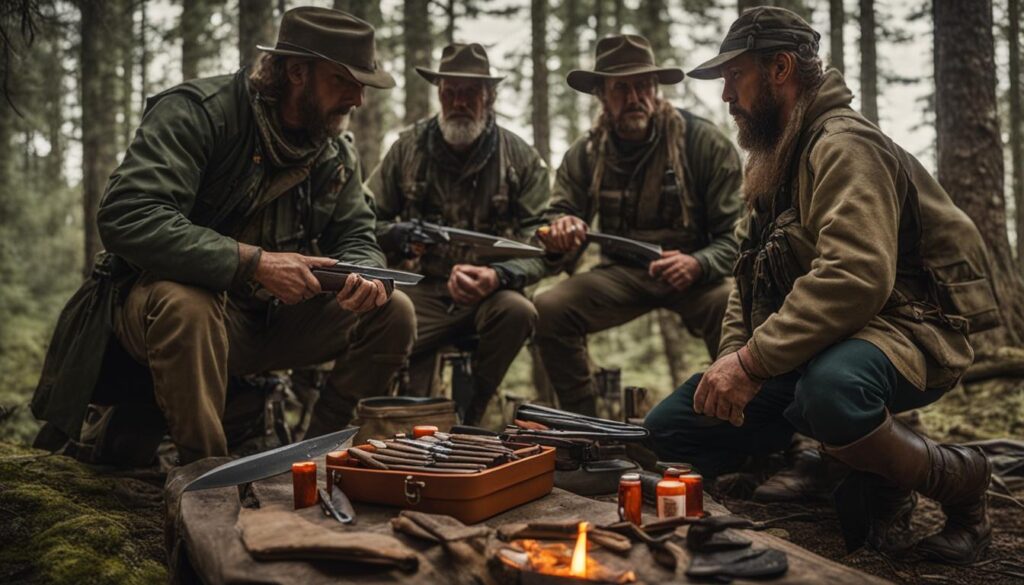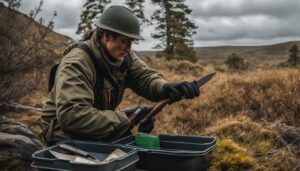Hunting is an exhilarating activity that requires careful consideration of safety measures, especially when it comes to handling knives. To ensure a safer hunting experience and prevent knife-related accidents and injuries, it’s essential to prioritize knife safety. By following these top tips, you can enhance your knife safety skills and enjoy a worry-free hunting adventure.
Key Takeaways:
- Always prioritize safety when using knives while hunting.
- Select the right knife for the specific tasks you will be performing.
- Maintain your knife properly through regular sharpening, cleaning, and lubrication.
- Create a safe environment by practicing safe knife handling techniques and being aware of your surroundings.
- Follow essential knife safety techniques, including proper grip and never attempting to catch a falling knife.
The Importance of Knife Maintenance in Survival Situations
Proper knife maintenance is crucial in survival situations to ensure the functionality and safety of your knife. By regularly sharpening, cleaning, and lubricating your knife, you can keep it in optimal condition and ready for any task that comes your way.
The Importance of Knife Sharpening
Knife sharpening is an essential maintenance task that should be done regularly. A sharp knife not only performs better but also reduces the risk of accidents caused by slips and uneven cuts. Invest in a quality sharpening tool and learn proper sharpening techniques to maintain a sharp edge.
The Significance of Knife Cleaning
Keeping your knife clean is vital for preventing rust, corrosion, and the buildup of dirt and debris. After each use, make sure to wipe down the blade with a clean cloth or paper towel. For tougher dirt, use mild soap and water, taking care to dry the knife thoroughly to prevent moisture-related damage.
The Benefits of Knife Lubrication
Lubricating your knife is essential to prevent rust and ensure smooth operation. Apply a few drops of oil or a specially formulated knife lubricant to the pivot points, blade, and other moving parts of your knife. This helps reduce friction and maintain the knife’s overall performance.
By prioritizing knife maintenance in survival situations, you can increase the longevity of your knife, improve its functionality, and reduce the risk of accidents. Remember to sharpen your knife regularly, keep it clean, and apply lubrication when necessary. With a well-maintained knife by your side, you can confidently tackle any challenges that come your way.
Choosing the Right Knife for the Task
When it comes to hunting, selecting the right knife is crucial for a successful and safe experience. There are several factors to consider when choosing a knife, including the type of knife, durability, and handle comfort.
Firstly, the decision between a fixed blade and a folding knife is important. Fixed blade knives are known for their strength and reliability, making them ideal for heavy-duty tasks such as field dressing and skinning game. On the other hand, folding knives offer convenience and portability, making them suitable for everyday carry and tasks that require precision.
Secondly, knife durability should be taken into account. Look for knives made from high-quality materials such as stainless steel or carbon steel, which offer durability and resistance to corrosion. A durable knife will withstand rigorous use and maintain its sharpness, ensuring efficient and safe cutting.
Lastly, consider the comfort of the knife handle. A comfortable grip is essential for maintaining control and minimizing the risk of accidents. Look for handles that fit well in your hand and offer a secure grip, whether they are made of wood, rubber, or synthetic materials.
By carefully considering these factors, you can choose a knife that is suited to your specific hunting needs and ensure a safe and enjoyable hunting experience.
Table: Comparison of Fixed Blade and Folding Knife
| Criteria | Fixed Blade Knife | Folding Knife |
|---|---|---|
| Strength and Reliability | High | Lower |
| Portability | Low | High |
| Precision | Lower | High |
| Durability | High | Lower |
| Handle Comfort | Varies | Varies |
Creating a Safe Environment
When it comes to knife safety, it’s not just about how you handle the knife but also the environment in which you’re using it. Creating a safe environment is crucial to minimize the risk of accidents and ensure the well-being of everyone involved. Here are some key considerations to keep in mind:
- Knife Safety Environment: Before you start using a knife, make sure you’re in a suitable location. Choose an area that provides ample space for you to maneuver the knife without any obstructions. Avoid crowded or confined spaces that could increase the likelihood of accidents.
- Blood Bubble: The concept of the “blood bubble” refers to the radius around you where your knife can reach. Keep others outside of this bubble to prevent accidental injuries. Be mindful of your surroundings and communicate with those around you to ensure everyone’s safety.
- Safe Knife Handling: Proper knife handling techniques are essential to maintain a safe environment. Always hold the knife by the handle with a firm grip and never by the blade. Keep your fingers away from the blade’s edge to avoid accidental cuts.
- Knife Storage: When the knife is not in use, it’s crucial to store it properly to prevent accidents and injuries. Keep the knife securely in its sheath or a protective cover to ensure that it is safely stored and cannot accidentally be grabbed or bumped into.
By creating a safe environment and practicing safe knife handling techniques, you can greatly reduce the risk of accidents and injuries. Remember, knife safety is not just an individual responsibility but also a collective effort to ensure the well-being of everyone involved in the hunting experience.

Essential Knife Safety Techniques
When it comes to handling knives, there are several essential safety techniques that every hunter should be aware of. By mastering these techniques, you can minimize the risk of accidents and ensure a safer hunting experience. Let’s explore some of these techniques in detail:
Grip Properly
The way you hold your knife plays a crucial role in ensuring safety. Always grip the handle firmly, with your thumb wrapped around the handle for stability. This grip provides better control and reduces the chance of the knife slipping from your hand during use.
Blood Bubble Awareness
Understanding the concept of the “blood bubble” is vital for knife safety. The blood bubble refers to the radius around you in which your knife can reach. Always be aware of your surroundings and ensure that no one is within this range while you are handling a knife. Keeping others out of your blood bubble significantly reduces the risk of accidental injuries.
Avoid Catching a Falling Knife
It may be tempting to try and catch a knife that is falling, but doing so is extremely dangerous. Instead of attempting to catch a falling knife, step back and let it fall to the ground. By avoiding this instinctive reaction, you can prevent potential injuries from a falling knife.


By following these essential knife safety techniques, you can enhance your skills and minimize the risk of accidents while hunting. Remember to always grip the knife properly, be aware of your blood bubble, and never attempt to catch a falling knife. Stay safe and enjoy your hunting experience!
Common Knife Safety Mistakes to Avoid
When it comes to knife safety, there are several common mistakes that can lead to accidents and injuries. By being aware of these mistakes and taking steps to avoid them, you can significantly improve your knife safety skills. Here are some of the most important knife safety mistakes to be mindful of:
- Over-Sharpening: While it’s important to keep your knife sharp for optimal performance, over-sharpening can be dangerous. A blade that is too sharp can easily slip and cause unintentional injuries. Follow proper sharpening techniques and avoid excessive sharpening.
- Neglecting Rust: Rust can compromise the integrity of your knife and make it less safe to use. Regularly inspect your knife for any signs of rust and clean it properly to prevent rust from forming. Remember to dry the blade thoroughly after cleaning to prevent further corrosion.
- Using the Wrong Lubricant: Lubricating your knife is essential for maintaining its functionality and preventing corrosion. However, using the wrong type of lubricant can do more harm than good. Make sure to use lubricants specifically designed for knife maintenance and avoid using substances that could potentially damage the blade.
By avoiding these common knife safety mistakes, you can ensure safer knife usage and reduce the risk of accidents and injuries. Remember to always prioritize safety and follow proper knife maintenance and handling techniques. Being proactive in preventing these mistakes can make a significant difference in your overall knife safety.
“Over-sharpening can be just as dangerous as using a dull knife. Finding the right balance is key to maintaining a sharp yet safe knife.” – Knife Safety Expert
Table: Common Knife Safety Mistakes and Prevention
| Common Mistake | Prevention |
|---|---|
| Over-Sharpening | Follow proper sharpening techniques and avoid excessive sharpening. |
| Neglecting Rust | Regularly inspect your knife for rust, clean it properly, and dry it thoroughly. |
| Using the Wrong Lubricant | Use lubricants specifically designed for knife maintenance and avoid using substances that could damage the blade. |
As a responsible knife user, it’s crucial to be aware of common knife safety mistakes and take appropriate measures to avoid them. By keeping your knife properly maintained, being mindful of excessive sharpening, addressing rust issues promptly, and using the right lubricant, you can ensure a safer and more enjoyable knife experience.
Practical Bushcraft Cutting Techniques
When it comes to bushcraft and knife usage, mastering safe cutting techniques is essential for both efficiency and safety. Whether you’re carving wood, preparing meals, or building a shelter, employing the right techniques can make all the difference. In this section, I will introduce you to two essential bushcraft cutting techniques: the Chest Lever Grip and the Knee Lever Grip.
The Chest Lever Grip
The Chest Lever Grip is a fundamental cutting technique that provides control and precision. To execute this grip, start by gripping the knife handle firmly, placing your thumb on the spine of the blade to guide and stabilize it. Position your other hand’s palm on the back of the knife blade, just above the handle, and wrap your fingers around it for additional support. By using your chest as a leverage point, you can apply controlled force while maintaining excellent blade control.
The Knee Lever Grip
The Knee Lever Grip is another useful technique, particularly for tasks that require downward cutting force. To perform this grip, kneel down and place the knife handle between your knees, ensuring it is secure. Grip the handle firmly with both hands, with one hand positioned near the blade’s base and the other at the opposite end. This grip allows you to exert downward pressure while maintaining stability and control.
By mastering these bushcraft cutting techniques, you can enhance your efficiency, accuracy, and safety when using a knife in the wilderness. Remember to always prioritize safety, take your time to practice these techniques, and gradually incorporate them into your bushcraft skills repertoire.
| Cutting Technique | Advantages | Disadvantages |
|---|---|---|
| Chest Lever Grip | Excellent control and precision | May require practice to master |
| Knee Lever Grip | Allows for downward cutting force | Requires kneeling position |
Conclusion
As I conclude this article, I want to emphasize the importance of prioritizing knife safety while hunting. By following these top tips for avoiding knife injuries, you can greatly reduce the risk of accidents and ensure a safer hunting experience.
Remember, knife safety starts with selecting the right knife for the task at hand. Consider factors such as the type of knife, its durability, and the comfort of the handle. A well-suited knife will not only enhance your performance but also reduce the chances of accidents.
In addition, proper knife maintenance is crucial. Regularly sharpening, cleaning, and lubricating your knife will keep it in optimal working condition and minimize the risk of accidents. Always store your knife safely in its sheath when not in use to prevent any unintended mishaps.
Lastly, practicing safe knife handling techniques is essential. Maintain awareness of your surroundings, be mindful of the direction the knife is pointing, and never attempt to catch a falling knife. By following these simple yet vital practices, you can prevent knife accidents and injuries while hunting.
FAQ
Why is knife safety important while hunting?
Knife safety is important while hunting to prevent accidents and injuries.
How can I maintain my knife for safe use in survival situations?
Regular sharpening, cleaning, and lubrication are essential for knife maintenance in survival situations.
What factors should I consider when choosing a hunting knife?
Consider factors such as knife type, durability, and handle comfort when choosing a hunting knife.
How can I create a safe environment while using knives?
Be aware of your surroundings, practice safe knife handling techniques, and store the knife safely in its sheath when not in use.
What are some essential knife safety techniques?
Some essential knife safety techniques include proper grip, maintaining awareness of your “blood bubble,” and never attempting to catch a falling knife.
What are some common knife safety mistakes to avoid?
Avoid over-sharpening, neglecting rust, and using the wrong lubricant to ensure safer knife usage.
Are there any specific cutting techniques I should learn for safe knife usage?
Yes, learning practical bushcraft cutting techniques such as the chest lever grip, knee lever grip, and scissor cut can help minimize the risk of accidents.
How can I enhance knife safety while hunting?
By following the top tips mentioned in this article, you can enhance your knife safety skills and enjoy a safer hunting experience.





